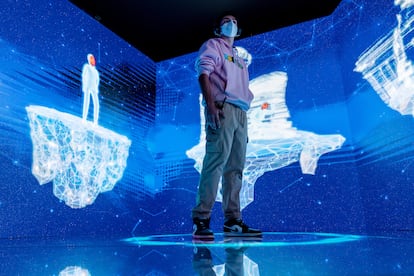The metaverse: The business of the century or a massive bubble?
Companies are rushing to develop a presence in the Web3 world, although its profitability is still unclear


On October 28, 2021, a gear was set in motion, and it is still turning. That day Mark Zuckerberg gave an hour-and-a-half presentation about his great project for the future: a virtual environment that he referred to as the “metaverse,” which he sees as “the natural evolution of the Internet.” To emphasize the gravity of his initiative, he closed his speech by announcing that his company would be known from that moment on as Meta. “Over time, I hope we are seen as a metaverse company,” he said.
The message had a deep impact, and for a nonexistent product, the expectations are high: the metaverse is already attracting million-dollar investments. It took Microsoft less than a week to enter the race to create the metaverse workplace, starting with offering customizable avatars for its Teams video-calling software. The company reinforced its efforts at the end of January with the €69,000 million purchase of Activision Blizzard, the video game company behind bestsellers including Call of Duty and World of Warcraft. The CEO of Microsoft, Satya Nadella, described the move as “a big step” towards the metaverse: the acquired company is dedicated to creating realistic interactive worlds.
Many other companies have followed. Niantic, Intel and Epic are all working on creating their own metaverses. Decentraland already has its own, and the Roblox and Fortnite video games could already be described as metaverses. Apple is also preparing its landing in this business. Brands including Nike or Gucci have started to organize events in virtual environments and develop limited series of products exclusively available in digital formats. The real estate fever has also reached hyperspace, with firms such as Earth2, Next Earth and Superworld dedicated to the purchase of land in the metaverse. Master’s degrees and university courses focused on the burgeoning new world have emerged. Some countries, such as the Caribbean island of Barbados, have decided to open virtual embassies. In March, Decentraland held the first entirely virtual fashion show, Metaverse Fashion Week (MVFW), featuring brands including Dolce & Gabbana, Tommy Hilfiger and Elie Saab.
Are we really facing the business opportunity of the century? Or is this another repeat of the dotcom bubble? Even if one or more metaverses are developed, will consumers want to enter them? “From an economic point of view, I see a huge risk,” says Manuel Hidalgo, professor of Economics at the Pablo de Olavide University in Seville and at the Esade Center for Economic Policy. “Before, someone would design a combustion engine and then business applications would come up, like cars. With the metaverse it happens the other way around: first I tell you what it is going to be like, and then, when you invest, I develop it.”
Million-dollar expectations
That has been Meta’s message. “The transformation we are launching may have a greater impact on our lives and on the economy than the smartphone has had in the last 10 years,” Laurent Solly, the company’s vice president for southern Europe, told EL PAÍS the day after Zuckerberg’s announcement.
When the young tycoon presented his idea to the world, Bloomberg Intelligence estimated that Zuckerburg could build a $800 billion industry by 2024. Citigroup analysts disagree: in a recent report, the report estimated the market making between $8 and $13 billion by 2030. Gartner predicts that, by 2026, 25% of the population will spend at least one hour a day in this virtual universe to work, shop, learn, interact or entertain. Citi believes the potential range of users is five billion people, more than half of humanity.
Many entrepreneurs already agree with those analyses. An Accenture study revealed that, out of 4,600 interviews with executives from 35 countries, 71% of business leaders believe that the metaverse will have a positive impact on their organization. And, though six months after Zuckerberg’s announcement we are still not sure exactly what the metaverse is, 42% think it will be a groundbreaking technology.
There is no single definition of the metaverse, a name taken from Neal Stephenson’s 1990s cyberpunk novel Snow Crash. There is not even a single metaverse, although Zuckerberg hopes his will prevail. There was already an attempt to bring this virtual world to homes just two decades ago: Second Life attracted large investments and plenty of headlines and now rests in peace.
The concept involves combining the physical and virtual worlds in immersive ways, through virtual reality or augmented reality. Technical advances and high-speed internet have greatly improved the experience of putting on 3D glasses. Today’s virtual worlds look nothing like Second Life. Entering Meta’s Horizon with the company’s Oculus Quest 2 glasses can give users a feeling of vertigo when walking through a gorge, or blind their eyes if they look at the sun above the landscape.
Sense of reality
Some companies are working on haptic garments that transmit pressure from other avatars or from bumping into objects in the Metaverse. The virtual reality glasses that Meta is preparing, which will improve on the Quest 2, currently on sale for about $300, will incorporate gaze sensors. The sensors will improve the user experience by bringing into focus only what the user looks at and reducing dizziness. They will also allow Meta to collect data on what catches users’ attention and for how long. Facial, lip and body recognition will observe users’ every movement. (It remains to be seen if that information will be used for other purposes.)
Other technical advancements have prepared the way for the metaverse. Cloud computing is expanding rapidly, allowing devices to be smaller and smaller without losing computing power. The financial system is undergoing a revolution thanks to cryptocurrencies and non-fungible tokens, or NFTs, digital payment methods ideal for these virtual environments. The metaverse promises to channel these innovations.
So what exactly is it? The Higher Institute for Internet Development (ISDI) proposes, after reviewing the existing literature to date, that a metaverse includes four characteristics: it must have a spatial or sensorial interface; the interface should give us access to an immersive world; in that world, the user’s avatar must be able to interact with other avatars and their environment; and there must be native virtual economies. Some of these elements are already present in video games or online stores. But until they occur at the same time, it cannot be defined as such.
Zuckerberg himself said at the project’s debut that it would take “years, perhaps decades” to be fully ready. To generate immersive, hyper-realistic graphics requires a lot of computing power and more latency (the time it takes for data to travel from one internet point to another and back) than we have today. We need better infrastructures and product.
Until those arrive, we will see intermediate phases of implementation: we will enter non-immersive spaces through our cellphones, and we will experiment with products that do not meet the four conditions indicated by ISDI but that are equally novel. Some of the trends have already arrived, such as online games in which players buy costumes, or skins, for their characters. This is one of the businesses anticipated to emerge: users will be willing to invest in customizing their avatars.

For Víctor Javier Pérez, coordinator of ISDI’s metaverse executive program, investments in this market fall in two categories: big technology companies are developing the hardware to make the metaverse work, and other companies are generating services for the environment. “There are many brands that do not understand very well what it is. They want to position themselves there and communicate it quickly. You have to offer value. The actions for right now are now brand positioning. The time will come to monetize,” he argues.
The Spanish company Virtual Voyagers has managed to sneak into the first group of innovators. In 2020, they were recruited by Meta to design an environment in which to host concerts. “It worked well. It showed that people could sustain connections of more than an hour and a half, as long as it was a social experience. Meta saw that these activities generate more engagement than video games,” says Edgar Martín-Blas, the start-up’s CEO. Virtual Voyagers is now working on designing the Vodafone metaverse.
The fashion giant Zara launched a so-called “phygital,” or physical and digital, collection, which featured real and virtual versions of garments. Nike has gone further and has marketed fully digital shoes as NFTs.
“We are seeing that companies in the retail sector use different approaches to enter the metaverse,” explains Antonio Calvo, head of distribution and mass consumption goods at SAS. “Some make investments in their own sales portals, such as the supermarket chain Mercadona, which is investing in start-ups that are developing in this area. Others are positioned in third-party spaces, such as the one in Fortnite. And others, like Walmart, invest in different technologies related to NFTs, cryptocurrencies or blockchain technology,” he says.
New habits
Then there is the generational aspect. Young people are the primary users of video games that incorporate elements present in the metaverse. Digital natives better understand the mechanisms of these virtual environments. In Fortnite, for example, concerts have been held with audience sizes that rival those of major sporting events. Rapper Travis Scott brought together 12 million viewers during a performance on a platform, and was seen in the following days by 27 million people.
It also happens that, in Spain, age goes hand in hand with significant differences in income. “I am a millennial. Many people of my generation cannot afford to buy a property and choose to acquire assets in the metaverse,” says Ekaitz Cancela, a researcher at the Internet Interdisciplinary Institute (IN3) of the Open University of Catalonia. “Real estate trading volume in the metaverse in the last quarter has increased by 150%,” he notes. It is estimated that the total figure last year exceeded $500 million, according to data from the specialized portal MetaMetric Solutions. “My generation, which has no experience buying houses or art, sees the metaverse as the way to establish itself as an aspirational middle class,” says Cancela.
The real estate aspect is one of the phenomenon’s most striking elements. The case of Gamium is illustrative: a group of blockchain entrepreneurs from Barcelona began a start-up to create their own virtual space. They want to develop a unique digital identity that allows them to enter not only their metaverse but also those of other companies. To test their plan, they put up for sale virtual land in their world. In less than a month, they made over a million dollars.
“We anticipate that there will be constant economic activity within the metaverse. In reality, it is a world that coexists parallel to the physical world and that can be monetized in infinite ways,” says Alberto Rosas, co-CEO of Gamium, speaking from Bali, Indonesia, a destination internationally known for digital nomads. “You can charge a commission for each transaction that is made. You can sell clothes and items for your avatar, create exclusive games that you can only access if you pay, or monetize through ads in the metaverse itself.”
All that is yet to come–or not. But, for now, money in the metaverse is being made in a familiar way: speculating on the land.
Tu suscripción se está usando en otro dispositivo
¿Quieres añadir otro usuario a tu suscripción?
Si continúas leyendo en este dispositivo, no se podrá leer en el otro.
FlechaTu suscripción se está usando en otro dispositivo y solo puedes acceder a EL PAÍS desde un dispositivo a la vez.
Si quieres compartir tu cuenta, cambia tu suscripción a la modalidad Premium, así podrás añadir otro usuario. Cada uno accederá con su propia cuenta de email, lo que os permitirá personalizar vuestra experiencia en EL PAÍS.
¿Tienes una suscripción de empresa? Accede aquí para contratar más cuentas.
En el caso de no saber quién está usando tu cuenta, te recomendamos cambiar tu contraseña aquí.
Si decides continuar compartiendo tu cuenta, este mensaje se mostrará en tu dispositivo y en el de la otra persona que está usando tu cuenta de forma indefinida, afectando a tu experiencia de lectura. Puedes consultar aquí los términos y condiciones de la suscripción digital.
More information
Últimas noticias
Most viewed
- Sinaloa Cartel war is taking its toll on Los Chapitos
- Oona Chaplin: ‘I told James Cameron that I was living in a treehouse and starting a permaculture project with a friend’
- Reinhard Genzel, Nobel laureate in physics: ‘One-minute videos will never give you the truth’
- Why the price of coffee has skyrocketed: from Brazilian plantations to specialty coffee houses
- Silver prices are going crazy: This is what’s fueling the rally










































